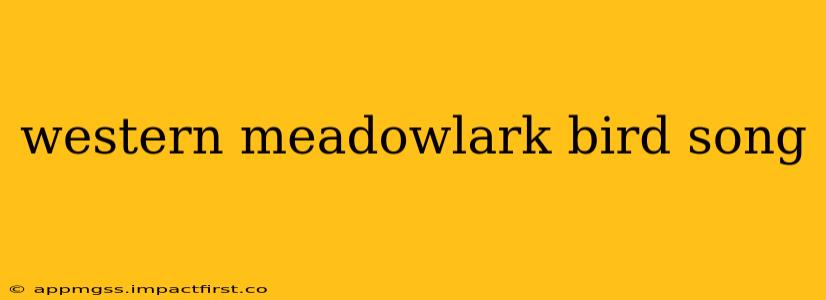The Western Meadowlark ( Sturnella neglecta ) is a quintessential symbol of the North American grasslands, its vibrant song a defining characteristic of its presence. This cheerful, bubbling melody is more than just a pretty sound; it's a complex communication system vital for territorial defense, mate attraction, and overall survival. This article delves into the intricacies of the Western Meadowlark's song, exploring its unique qualities, variations, and significance in its ecosystem.
What does a Western Meadowlark sound like?
The Western Meadowlark's song is easily recognizable, often described as a clear, flute-like melody with a distinctive, bubbling quality. It's typically a series of high-pitched whistles and trills, often characterized by a descending scale at the end. The song is remarkably complex, with individual birds possessing unique variations and repertoires. Think of it as a personalized musical signature, subtly different from every other bird’s rendition. While there's a common thread amongst all Western Meadowlark songs, the subtle nuances are what distinguish one singer from another. This allows for individual recognition within the population.
How can I tell the difference between Eastern and Western Meadowlark songs?
While both Eastern and Western Meadowlarks share similar song structures, subtle differences exist that can help distinguish between the two. The Western Meadowlark's song is generally considered clearer, brighter, and more melodious than its Eastern counterpart. The Eastern Meadowlark’s song often has a slightly harsher quality, less of the clear, flute-like notes prominent in the Western species' song. Furthermore, the Eastern Meadowlark’s song often includes more varied notes and a less consistent descending pattern. Experienced birders can often distinguish between the two by ear, but learning to recognize these nuanced differences takes time and practice.
What is the purpose of the Western Meadowlark's song?
The Western Meadowlark's song serves multiple crucial functions:
-
Territorial Defense: Males use their songs to advertise their territory and warn off rivals. The louder and more frequent the singing, the more effectively a male asserts his dominance over his patch of grassland.
-
Mate Attraction: The song is a crucial element of courtship. Females are attracted to males with complex and varied songs, indicating superior fitness and genetic quality. A male with a particularly impressive repertoire is more likely to secure a mate.
-
Individual Recognition: As mentioned earlier, subtle variations in song allow individual birds to be recognized within a population. This is crucial for maintaining social structures and avoiding unnecessary conflict.
What time of year do Western Meadowlarks sing?
Western Meadowlarks are most vocal during the breeding season, typically from spring to early summer. The frequency and intensity of their singing reach a peak during this period, as males compete for mates and defend their territories. While they might sing sporadically throughout the year, the most robust and frequent singing is undeniably linked to the breeding cycle.
Do female Western Meadowlarks sing?
While male Western Meadowlarks are known for their elaborate and frequent songs, female Western Meadowlarks also sing, though less frequently and with simpler songs compared to their male counterparts. Their vocalizations are often quieter and less complex, serving primarily for communication within their territories or to their young.
How is the Western Meadowlark's song learned?
Young Western Meadowlarks learn their songs through a process called vocal learning. They learn by listening to and imitating the songs of adult males, particularly their fathers. This learning process is crucial for the development of their individual song repertoires and the maintenance of species-specific vocalizations.
Why is the Western Meadowlark's song important?
Beyond the bird's own survival, the Western Meadowlark's song is an important indicator of grassland health. The presence of robust singing males suggests a healthy and thriving grassland ecosystem. The decline in Western Meadowlark populations in certain areas can be an early warning sign of habitat degradation or loss. The vibrant song, therefore, serves as a natural indicator of environmental well-being.
This exploration of the Western Meadowlark's song highlights the remarkable complexity and importance of avian vocalizations. By understanding these subtle nuances, we can gain a deeper appreciation for the rich tapestry of life in the grasslands and the vital role these captivating birds play within their environment.
